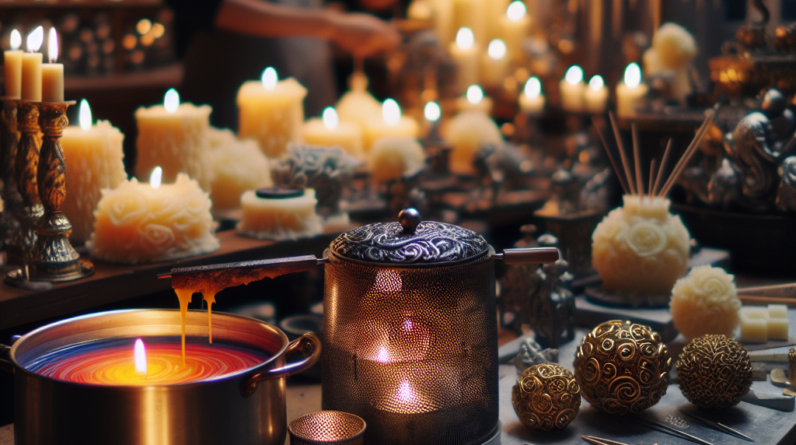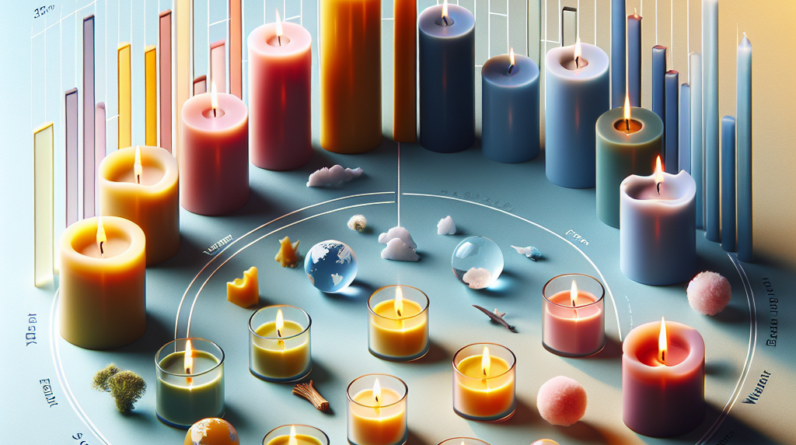
Understanding Aroma Chemistry
What is Aroma Chemistry?
So, I’ve always been fascinated by how certain scents can evoke so many different feelings. Aroma chemistry is really the foundation of what makes a candle delightful. It deals with how different chemical compounds combine to create a scent that can be sweet, musky, fresh, or even floral. Knowing this helps me appreciate the diversity of scents available out there!
When we think about it, really any kind of fragrance we encounter is a product of aroma chemistry at work. For candles, it’s crucial to understand how essential oils, synthetic fragrances, and natural waxes play into the final scent experience. Each scent evokes various memories and sensations, connecting us to our experiences.
As I began exploring this world deeper, I realized the potential for manipulation within aroma chemistry—like how a slight change in temperature or mixture can create a completely new scent. That’s the magic of candle-making—it’s both a science and an art!
The Role of Essential Oils
Essential oils are the superhero of the candle world. They serve not only to provide scent but also to introduce various therapeutic benefits. Different oils can help with stress relief, energy boosts, and even mood enhancement. I love selecting oils that fit the vibe I want to create with my candles.
For instance, lavender is often associated with relaxation, which makes it perfect for a calming bedtime candle. On the other hand, citrus oils, like lemon or orange, can instantly uplift the mood and energize. Choosing the right essential oils is critical to achieving the desired effect when lighting up a candle in your space.
But it’s not just about the scent. The purity and quality of the oils make a huge difference. Affordable options might save some cash initially, but I learned the hard way that they often lack the depth and complexity of high-quality essential oils. It’s something I keep in mind every time I dip into my candle-making supplies.
Balancing Scent Profiles
Creating a good scent isn’t just about throwing a few oils together; it’s like composing music! Each oil has its own character, and finding the right balance is vital. You want all the aromas to harmonize rather than compete. This balancing act is both exciting and daunting!
I’ve spent countless weekends experimenting—some spectacularly successful, some… let’s just say, less so. But that’s all part of the fun. By tweaking one ingredient at a time, I’ve slowly mastered how to create a multisensory experience that captivates those who catch a whiff of my candles.
Sometimes I take inspiration from other candles I admire, dissecting their scent profiles until I understand why some draw me in. This endless journey of learning has made me appreciate the subtle nuances that make my favorite candles so special.
The Art of Wax Selection
Diving Into Different Wax Types
When I first started making candles, I was amazed by the variety of wax types available! From paraffin to soy to beeswax, each type provides a different burn experience and scent throw. For me, it became a quest to discover which wax produces the best results according to the scents I love.
Each wax type has its pros and cons. For example, while paraffin can hold more fragrance and generally burn cleaner, I often opt for soy wax for its sustainability factor. It’s also known for providing a longer burn time, which is a huge plus in my book!
Beeswax is another enticing option because of its natural honey scent and gorgeous golden hue. Yet, it can be pricey and temperamental, so I keep it for special projects that call for that touch of luxury. Choosing the right wax really sets the stage for everything that follows in the candle-making process.
Wick Choices Matter
Oh man, let’s talk wicks! Choosing the right wick is just as crucial as figuring out your wax and scent. It not only affects how well your candle burns but also how evenly it distributes fragrance. I’ll never forget the time I used a wick that was way too small for the jar, leading to a non-thrilling burn that left me utterly disappointed.
Now, I favor wooden wicks for their rustic charm and the crackling sound they make—almost like a fireplace! That cozy vibe transforms the atmosphere of my home, making it feel warm and inviting. However, I also experiment with cotton wicks, which provide a different burn quality and scent throw.
The size, material, and even the way wicks are made all contribute to the quality of the burn. I’ve found that testing and keeping records of various wick styles has truly leveled up my candle game!
Testing for Quality
The final stage before declaring a candle “complete” is testing. Seriously, if you skip this step, you’re asking for trouble! After spending hours creating this masterpiece, the last thing I want is to have it burn poorly or not smell like I envisioned.
I’ve got a little testing station set up in my home where I light my candles and note how they burn over several uses. I evaluate things like the scent throw, the burn time, and how well the wax pools. It’s a mix of science and passion that ensures every candle I produce meets my standards.
This phase can get a bit tedious but trust me, it’s worth it! Nothing beats the satisfaction of lighting a candle and smelling that enchanting fragrance waft through the air, knowing I put my heart and soul into perfecting it.
Packaging and Presentation
Why Packaging Matters
You might think that once you’ve crafted a stunning candle, your work is done. Nope! The packaging is the cherry on top. It serves not just as protection, but also as the first impression for potential buyers. I’ve learned that beautiful packaging can elevate a simple candle into a designer product.
When I’m designing my labels and boxes, I always consider the aesthetic and message I want to convey. Elegant colors and streamlined designs often work wonders for a luxe feel, while more playful styles might attract a different clientele. Balancing creativity and professionalism in packaging has been a fun challenge.
Moreover, sustainable packaging is gaining traction, and I’ve found myself leaning towards eco-friendly materials. It’s a way to show my commitment to the environment, which has resonated well with my customer base. Sustainable does not mean sacrificial; my innovative packaging choices reflect my brand values.
Getting Creative with Branding
Having a memorable brand is essential! It’s remarkable how a well-crafted story can resonate with consumers. When I brand my candles, I share the journey of how they came to life and the inspiration behind each scent. This personal touch has helped me create a loyal customer base.
Colors, fonts, and visuals all contribute to building this brand identity. I’ve tried various styles to see what sticks, but each trial has taught me something valuable about myself and my audience. Taking feedback and keeping my brand fresh and engaging is where the real excitement lies!
Sometimes I even collaborate with local artists or businesses to offer limited edition releases, creating buzz and drawing in new customers who appreciate creativity and collaboration. It just feels good to build community while growing my brand!
Marketing My Candles
Let’s not forget about getting the word out! Marketing is where I can really highlight the uniqueness of my candles. From social media campaigns to pop-up shops, every channel offers a different opportunity to connect with my audience. I’ve made it a mission to share behind-the-scenes insights into the process, which not only educates but also engages buyers.
I often leverage customer testimonials and beautifully styled photographs to showcase my products online. My favorite platforms to promote my candles are Instagram and Pinterest, given their visual nature. These platforms allow me to express my creativity and attract potential customers through compelling visuals.
Ultimately, it’s about creating a community around my brand. I encourage engagement from customers—whether it’s asking about their favorite scents or sharing candle-making tips. This relationship-building makes the entire process more rewarding, and I can’t imagine doing it any other way!
Frequently Asked Questions
What makes designer aroma candles different from regular candles?
Designer aroma candles typically focus on high-quality ingredients, unique scents, and thoughtful branding. The processes involved are more intricate, leading to candles that not only look and smell great but also offer a luxurious experience.
Are essential oils better than synthetic fragrances for candles?
It really depends on personal preference! Essential oils are often viewed as more natural and can have therapeutic benefits. However, synthetic fragrances can provide a broader range of scents and often hold up better in the long run. It’s all about finding what works best for you.
How do I choose the right wick for my candle?
Choosing the right wick involves considering the wax type and the diameter of your candle. A well-chosen wick will lead to a clean burn and an effective scent throw. It may take some experimentation, but testing various wick sizes and materials will help you figure out what works best!
What are some tips for effective candle testing?
Set up a dedicated space for testing, where you can carefully monitor how your candles burn over several uses. Pay attention to the scent throw, the evenness of the burn, and how much wax remains. Keeping notes during tests will refine your process over time!
How important is packaging in selling candles?
Packaging is crucial! It can make or break your candle’s appeal. Great packaging not only protects your product but also conveys the brand’s identity. Beautifully designed packaging can attract customers and is often what captures buyers’ interest first.
Related Content
- Candle Trends for 2024: Why Resin Candles Are Leading the Way
- The Ultimate Guide to Choosing Unique Resin Candle Designs for Your Home
- How to Correct Common Mistakes in Resin Candle Making
- Exploring the Mystique of Stone and Resin: How These Candles Capture Light
- Building a Community Around Your Resin Candle Brand






